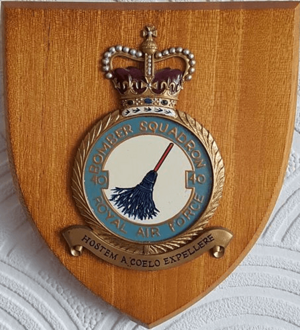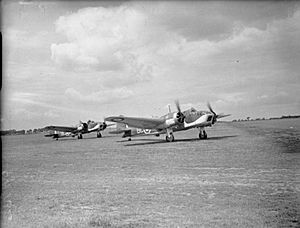No. 40 Squadron RAF facts for kids
Quick facts for kids No. 40 Squadron RAF |
|
|---|---|
 |
|
| Active | 26 February 1916 - 4 July 1919 1 April 1931 – 1 April 1947, 1 December 1947 – 15 March 1950, 28 December 1953 – 1 February 1957 |
| Country | |
| Branch | |
| Motto(s) | Latin: Hostem acolo expellere ("To drive the enemy from the sky") |
| Insignia | |
| Squadron Badge heraldry | A broom. The broom was chosen to immortalise the frequent exhortation of Major 'Mick' Mannock, the famous World War I pilot, who served with the squadron, to "sweep the Huns from the air!" |
| Squadron Codes | OX Oct 1938 – Sep 1939 BL Sep 1939 – Apr 1947 LE Jun 1949 – Mar 1950 |
No. 40 Squadron was a special group of pilots and planes in the Royal Air Force (RAF). It started in 1916 as part of the Royal Flying Corps. The squadron flew its last mission in 1957. Many pilots from other countries, like Australia and Canada, also joined this squadron.
Contents
The Story of No. 40 Squadron
Flying in World War I
No. 40 Squadron Royal Flying Corps began on February 26, 1916, in Gosport. At first, they used different training planes. In July, they received their main fighter plane, the Royal Aircraft Factory F.E.8. This was a single-seat plane where the propeller was at the back. No. 40 Squadron was the first group to use this plane.
The squadron moved to France in August 1916. The F.E.8 was easy to fly but was already old-fashioned. On March 9, 1917, nine of their F.E.8s were attacked by German fighters. These German planes were from Jasta 11, led by the famous pilot Manfred von Richthofen, also known as the Red Baron. All nine F.E.8s were shot down or had to land quickly. One German plane, flown by Richthofen, was damaged.
Later that month, the squadron got better planes called Nieuport 17s. Even though the F.E.8 was old, the squadron still shot down 16 German planes with it. One pilot, Edwin Benbow, claimed eight victories while flying the F.E.8.
The Nieuport planes helped No. 40 Squadron become more effective. They flew missions to attack German targets, including enemy Observation balloons. In April 1917, they helped the British attack at the Battle of Arras. They destroyed four balloons and damaged four more in one attack. They also helped in the Battle of Passchendaele.
In October 1917, the squadron got new planes, the Royal Aircraft Factory S.E.5s. They used these planes for the rest of the war. In March 1918, during the German spring offensive, the squadron flew many missions. They attacked German forces on the ground. On April 1, 1918, the squadron became part of the new Royal Air Force. They continued to fight, supporting the Hundred Days Offensive.
By the end of World War I, the squadron had shot down 130 enemy planes and 30 balloons. They also forced 144 planes to land out of control. Many famous pilots, called "aces," served with No. 40 Squadron. These included Edward Mannock, who got 16 of his 61 victories with them. The top ace in World War I for this unit was George McElroy. He scored 30 of his 47 victories while flying an S.E.5a.
Reforming and New Planes
No. 40 Squadron started again on April 1, 1931, at RAF Upper Heyford. They became a day bomber squadron. They were the first squadron to use the Fairey Gordon plane. In October 1932, they moved to RAF Abingdon. In November 1935, they got new planes, the Hawker Hart.
In March 1936, the squadron changed to the Hawker Hind. This was an improved version of the Hart. In July 1938, the squadron replaced its older biplanes with Fairey Battle monoplanes. The last of the Hinds left in September that year. After the Munich Agreement in 1938, war with Nazi Germany seemed likely. Plans were made to send the Battle planes to France. This was to help them reach German factories.
World War II Missions

On September 2, 1939, the squadron flew its Battle planes to France. This was just before Britain declared war on Germany. It soon became clear that the Battle plane was too old for modern war. The squadron mostly did training missions. In December 1939, the squadron left France. They got new twin-engine planes, the Bristol Blenheim Mk IV light bombers. They moved to RAF Wyton.
On May 10, 1940, Germany invaded France and other countries. No. 40 Squadron flew a reconnaissance mission over the Hague. This led to attacks on German airfields. No. 40 Squadron attacked Ypenburg Airport. This was their first bombing attack of the war. The squadron kept attacking German forces. Sometimes they flew from airfields in France.
Later in May, No. 40 Squadron attacked German forces. These forces were moving towards British troops trapped at Dunkirk. They attacked enemy vehicles and tried to block roads. After France fell, they attacked barges. These barges were waiting at ports for a planned German invasion of Britain.
On November 1, 1940, the squadron changed its role. They began night bombing missions against German factories. For this, they converted to Vickers Wellington planes. Their first Wellington mission was on December 21, 1940. Three planes attacked docks in Antwerp.
In October 1941, most of the squadron moved to Malta. They attacked Italian airfields and ports. This was to stop supplies from reaching North Africa. They also flew long missions to bother the enemy. These missions forced anti-aircraft guns to keep firing. This kept workers awake and hurt enemy morale.
The part of the squadron in Britain was rebuilt. On February 14, 1942, this part became No. 156 Squadron RAF. The part in the Mediterranean kept the No. 40 Squadron name. They moved to Egypt. They spent several months getting back to full strength after losses in Malta.
During the Second Battle of El Alamein, No. 40 Squadron attacked the important port of Tobruk. They also attacked enemy airfields and groups of troops. After the Allied victory, the squadron moved west. They helped attack the supply lines of the retreating German and Italian forces. From November 1942 to January 1943, their planes were in Malta. Their job was to stop Axis supplies to North Africa.
By February 1943, the squadron was in Tunisia. Here, they replaced their old Wellington Mk Ic planes with newer Wellington Mk IIIs. On February 18, No. 40 Squadron joined the new Northwest African Strategic Air Force. They flew missions against targets in Sicily during the Allied invasion of Sicily in July–August 1943.
The squadron moved to Southern Italy in December 1943. This brought them closer to targets in Northern Italy and the Balkans. They operated from Foggia Main airfield for the rest of the war in Europe. In March 1945, the squadron got Consolidated Liberators. Their last mission of the war was on April 25, 1945. They attacked railway yards in Austria.
After the War
The Squadron returned to Egypt in October 1945. They changed to Avro Lancaster planes in January 1946. Then, they were disbanded on April 1, 1947.
In 1947, the RAF decided their transport squadrons were too big. So, smaller units were formed. No. 40 Squadron started again with Avro York transport planes. This was on December 1, 1947, at RAF Abingdon. From June 1948, the Soviet Union blocked routes to Berlin. The Western Allies started the Berlin Airlift to supply the city.
The York planes of No. 40 Squadron went to RAF Wunstorf in West Germany. Their planes and crews helped in the airlift. The Yorks usually carried flour or coal. The Soviets ended the blockade in May 1949. No. 40 Squadron left the airlift in July 1949. They were disbanded on March 15, 1950.
On October 28, 1953, the squadron started again. They became a light bomber squadron with English Electric Canberra B.2s. They were one of five Canberra squadrons at RAF Coningsby. In 1954, No. 40 Squadron moved to RAF Wittering. In November 1956, the squadron moved to RAF Upwood. On December 15 that year, the squadron joined with 50 Squadron. The new unit was called 50/40 Squadron. This meant No. 40 Squadron was effectively disbanded for the last time.
See also
- List of Royal Air Force aircraft squadrons



